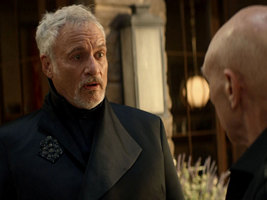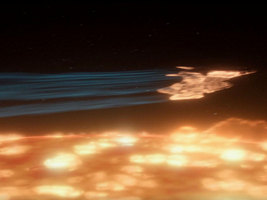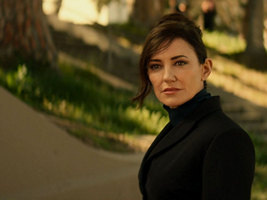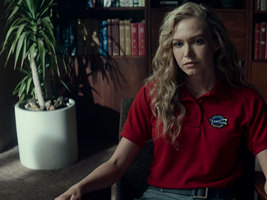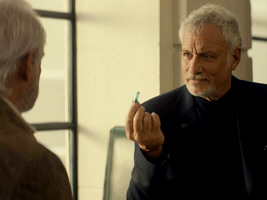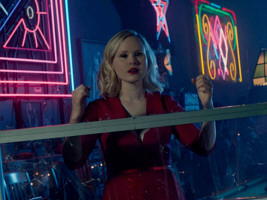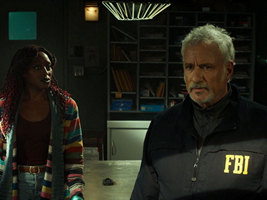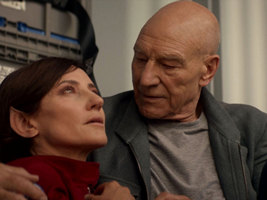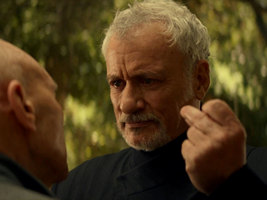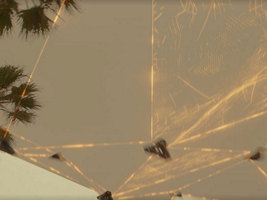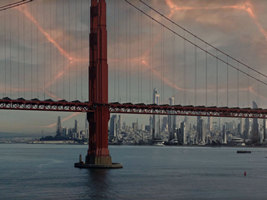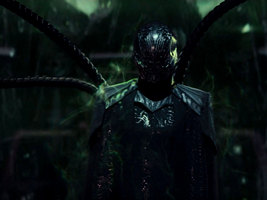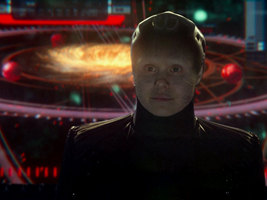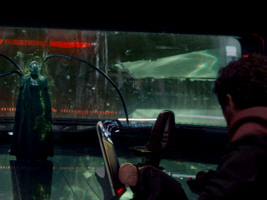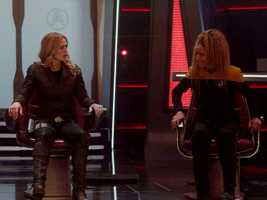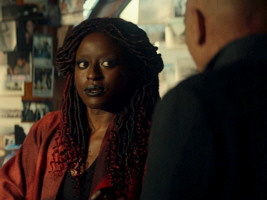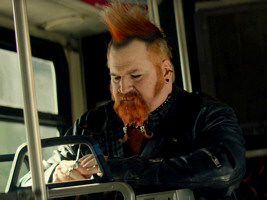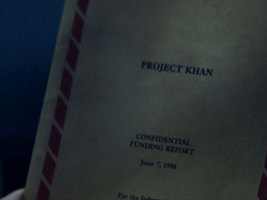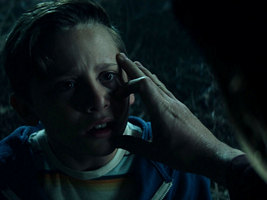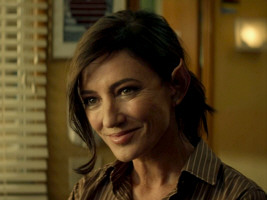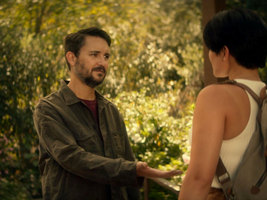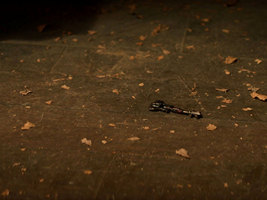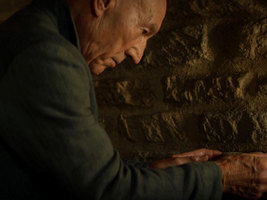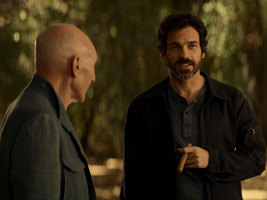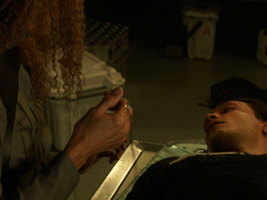Time Travel in Star Trek: Picard (PIC)
"Move backward to go forward. Shatter to mend. The past is now." (Borg Queen, PIC: "Assimilation")
Season 2
The whole second season of Star Trek Picard is a time travel arc that involves several different temporal phenomena. Some of them can be attributed to tampering by Q, some are the results of the characters' actions. The rest, and most notably the numerous coincidences in the story, remains unexplained.
Here is a recap of the sequence of events in the chronological order that the characters (and the viewers) experience, ordered by episodes:
- PIC: "The Star Gazer": In 2401, a message from an anomaly says "Help us, Picard", upon which the admiral arrives on the USS Stargazer under the command of Captain Rios. Seven of Nine and Jurati are present as well, while Raffi and Elnor are on the nearby USS Excelsior. The message comes from a Borg ship. The Borg Queen appears on the bridge of the Stargazer and is about to take control of the ship and of the rest of the fleet. Picard has no other choice but to order the self-destruct. The Stargazer explodes. Picard wakes up in his château whose interior has changed. He is greeted by Q, who announces another trial.
- PIC: "Penance": Picard learns from Q that he is in a changed reality. He is General Picard of the xenophobic Confederation now. A certain Adam Soong is revered as an important historical figure. Earth's atmosphere requires frequent cleaning in this timeline. Seven, as an unassimilated Annika Hansen, finds herself as the President of the Confederation. Jurati is a scientist, who has prepared the captured Borg Queen for public execution. The Queen, with her interdimensional perception, reveals that the point of divergence is in Los Angeles in the year 2024, and that a "Watcher" may help them. Together with Rios, Raffi and Elnor, they decide to travel to the past to fix the timeline. They need the Borg Queen to perform the slingshot maneuver with La Sirena. When the ship is boarded by Confederation officials, Elnor gets shot and later dies.
- PIC: "Assimilation": La Sirena arrives in the year 2024 and lands in La Barre near the Château Picard. Rios, Seven and Raffi beam to Los Angeles to scan for the anachronistic technology of a Watcher. But Rios is injured and taken to a hospital where Dr. Teresa Ramirez treats him. On La Sirena, Jurati taps the mind of the Borg Queen to obtain further information on what caused the timeline to diverge. She manages to retrieve a set of coordinates and narrowly escapes her assimilation.
- PIC: "Watcher": Multiple occurrences of the number 15 in the long abandoned Château Picard point to the date of April 15 being important. Picard then beams to the coordinates that Jurati extracted from the Borg Queen's mind. It is the site of Guinan's bar. Guinan does not recognize him, and she also says she is not a Watcher. But she eventually agrees to arrange a meeting with a Watcher. After appearing in various host bodies, the Watcher finally turns out to be a woman who looks just like Laris, the admiral's Romulan friend in the future. Q too is in the year 2024. A few days earlier, he attempted to snap his fingers to influence a young woman's mind, but it didn't work as expected.
- PIC: "Fly Me to the Moon": The Watcher that Jean-Luc Picard meets is not Laris but actually Tallinn, a Supervisor of the kind of Gary Seven. She has been watching over NASA astronaut Renée Picard for 24 years. April 15, the day that she is going on the groundbreaking Europa Mission to the moons of Jupiter, is just a few days away. But a psychiatrist in Tallinn's surveillance records strives to talk her out of it, attesting that she suffers from anxiety. Picard recognizes the man as Q. As a plan B, Q approaches the scientist Adam Soong to do him a favor, in exchange for a cure for his daughter Kore. She suffers from a genetic defect and can't leave the house. On La Sirena, Jurati kills the Borg Queen with a gun. Tallinn, Picard, Raffi, Seven and Jurati prepare to protect the astronaut during a NASA event just before she goes into quarantine for her flight.
- PIC: "Two of One": At the NASA gala, Jean-Luc Picard talks to Renée to encourage her. Adam Soong attempts to run over her with his car but hits the admiral. Picard is taken to Teresa's clinic. Prior to the Queen's death, Jurati has allowed herself to be assimilated in order to be able to travel back to the future and now possesses enormous powers that are steadily growing. Kore discovers that she is the latest of several failed genetic experiments of Adam Soong.
- PIC: "Monsters": Tallinn enters the mind of the still unresponsive Picard. She finds out that his mother suffered from a mental illness and that his father's violence he remembers was only his desperate attempts to keep her from running away or hurting herself. When he wakes up, Tallinn reveals that she is Romulan, like Laris. Seven and Raffi follow the traces of Jurati, who is on the loose, and conclude she needs endorphins to produce nanoprobes and accelerate her transformation to a new Queen. Picard decides to confront Q and goes to Guinan, who knows a way to summon him. But instead of Q, a police officer appears and arrests the pair.
- PIC: "Mercy": Raffi and Seven encounter Jurati, who attacks but does not kill them. Q appears to Kore and provides her with a cure for her condition. At the police station, Guinan encounters Q and realizes that he is dying. He gives her a cue about the FBI officer Wells that arrested her. Wells is keen on finding evidence of aliens because he himself witnessed Vulcan visitors in his childhood. He eventually agrees to release Guinan and Picard. Jurati visits Soong, who is heartbroken because Kore has left him. She tells him he will be famous and powerful if only he prevents Renée Picard from going on the Europa Mission where she would make a discovery that would render his work obsolete. Soong then arranges a meeting with a group of mercenaries, upon which Jurati begins to assimilate them.
- PIC: "Hide and Seek": The Borg Queen aka Jurati and the Borgified mercenaries beam aboard La Sirena. However, she does not succeed in launching the ship as intended because Jurati encrypted the command console with a code she did not memorize. An Elnor hologram has the code for the ship's command functions, which allows Seven and Raffi to beam away the attackers, leaving the Queen as the only Borg on the ship. A fight ensues, in the course of which the Queen pierces Seven with a tentacle. Inside the Queen's mind, Jurati suggests to form a new kind of Borg Collective, one that has mercy and that honors the individuality of its members, just like Seven of Nine. The Queen repairs Seven's wounds with nanoprobes, thereby also restoring her Borg implants. In the solarium of the château, Picard finds a key and remembers that it was (or will be) in this very room that his mother hung herself. He blames himself for unlocking the bedroom door that day, against his concerned father's request. The Queen takes the ship and leaves with the enigmatic comment that to succeed, "there must be two Renées, one who lives and another one who dies."
- PIC: "Farewell": After La Sirena has lifted off with the Borg Queen, Tallinn proceeds to the quarantine section to talk to Renée Picard. When Soong appears and demands to speak to the astronauts, Renée approaches him, saying that a strange woman stalked her. Soong infects her with a lethal neurotoxin. But the woman he poisoned was actually Tallin in disguise. Back in his house, Soong witnesses how the real Renée reports how her mission is on track, and then how all of his files are being remotely deleted by Kore. He pulls a folder from his drawer, labeled "Project Khan". Kore receives a message to meet with a person, who turns out to be Wesley Crusher. He invites her to become a Supervisor or Traveler. At the château, Picard puts back the key behind a brick, for him as a boy to be found in the future. Q tells him that it was the right decision to make. He confirms that he is dying but that he doesn't want to die alone. He is going to send Picard's crew back to the 24th century, which will probably kill him. But Rios chooses to stay behind with Teresa and her son Ricardo. Picard hugs Q, and finds himself back on the Stargazer, as the Borg Queen is tapping the systems. He halts the countdown for the self-destruct. The Borg Queen turns out to be Jurati. She needs control of all ships to create a shield strong enough to block the eruption of a massive anomaly. The admiral puts Seven in command and orders all ships to stand down. It turns out that in this timeline Elnor is alive and back on the Excelsior. The shield bubble created by the fleet holds and saves the lives of billions. At Guinan's bar, Picard learns that Rios and Teresa lived a happy life together, and that Ricardo worked out a method to clean up Earth's atmosphere based on an alien organism found by Renée Picard on the Europa Mission.
In a simplistic approach, the events of season 2 are the result of a predestined timeline, plus some limited tampering by Q. The cleaned up sequence of events would be as follows:
- In the original timeline, Renée Picard goes on the Europa Mission, discovers an alien microorganism that will help to clean up the Earth's polluted atmosphere. Everything else in history is just as we know it, up to the point in the year 2401 when the Borg Queen (actually the assimilated Jurati who has traveled to the future) calls Picard for help.
- The Borg Queen aka Jurati does not manage to convince the admiral to trust her. She is masked, so Picard doesn't recognize her and also doesn't understand the cue of her playing "Non, je ne regrette rien". He thinks it is an attack and orders the ship's self-destruct. Everyone dies.
- But Q interferes. He transfers the consciousnesses of Picard, Seven, Rios, the not yet assimilated Jurati, Raffi and Elnor to the people they are in an altered timeline. This is particularly noticeable in the case of Seven, who has never been assimilated in this branch of time.
- The new branch has its point of divergence in the year 2024 in Los Angeles. It is the flight of Renée Picard, which was somehow prevented. She did not discover the alien microbe, and Earth had to use Adam Soong's shield technology for atmospheric cleaning. This technology can be seen in its infancy in 2024 and also in the altered timeline in 2401. We can also see the statue of Soong in front of the Confederation government buildings. For some reason, Earth also becomes extremely xenophobic.
- Picard and company travel back to the year 2024, prior to the point of divergence. Elnor is killed, and there is no way of telling whether he may come alive again. With the help of Guinan and Tallinn, and also some cues by Q, Picard finds out that their mission is to make the flight of Renée Picard happen in order to restore the future they know. Q too is in the year 2024 and continues to try to sabotage the future, but his powers dwindle so he recruits Soong to do the dirty work for him.
- With Q being unable to simply dissuade or kill Renée Picard, the timeline change would probably be brought about by Adam Soong killing her at some point. We see how he tries to do it at the party and once again when she is in quarantine before the mission, attempts which are thwarted by Jean-Luc Picard and by Tallinn, respectively.
- The original timeline is eventually restored as the Europa Mission successfully launches with Renée Picard aboard.
- After the new Queen aka the assimilated Jurati has escaped with La Sirena, Q uses his remaining powers to transfer everyone but Rios back to the year 2401, and to the exact time when Picard has to make the decision whether to trust the Borg Queen or not. He is now aware that the Borg Queen has to be Jurati and accordingly halts the self-destruct. Q also restores Elnor.
This sequence of events seems to include a predestined history. The Borg Queen aka Jurati appears on the Stargazer before she actually comes to existence. The unassimilated Jurati is even present to witness the arrival of her future self, at least when it happens "for the first time" in PIC: "The Star Gazer". Jurati would be actually assimilated only after having been saved by Q and transferred to an alternate timeline and after having traveled back to the year 2024.
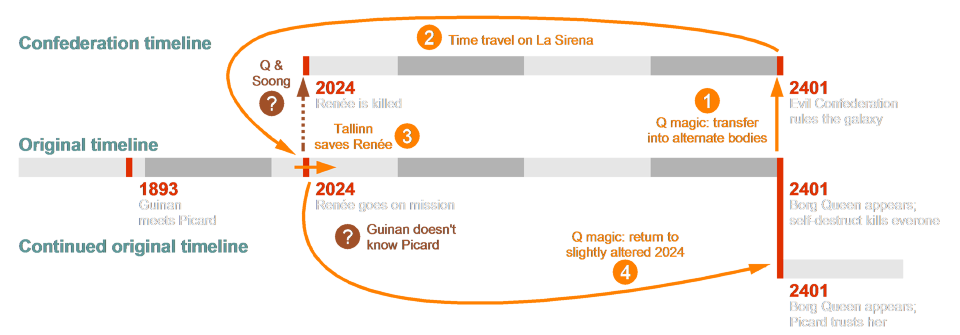
Simplistic interpretation As we try to sketch up the timelines in such a simplistic view, there are four events in which either a change occurs or in which characters travel through time or from one branch to another. After a normal passage of time until 2401, Q magically transfers Picard and company to their alternate Confederation bodies of the same time (1). They then travel back to 2024, prior to the point of divergence, and still on the original timeline (2). Tallinn saves Renée's life and thereby restores the future of the original timeline (3). Q transfers everyone to 2024 and brings Elnor back (4).
The diagram already takes into account that the encounter with the Borg Queen in 2401 changes from "The Star Gazer" to "Farewell". Not only the outcome is different but also the involved people (Jurati and Rios are not present on the bridge any more whereas Raffi is). Even the ships in the fleet differ on close investigation, although this may be a matter of artistic license, rather than an intentional change that is supposed to have a significance. The causality loop is not quite as well closed as we would like it to be. Still, we can recognize the broad strokes of a predestined history.
There are a couple of problems with this interpretation, however. If we leave aside the severe issues with the plausibility of the Confederation and the countless other coincidences that I will address later, there are two issues with this idea. The first is the question what created the Confederation timeline in the first place. We know that somehow Soong must have murdered Renée on Q's behest. But this never happens, and it technically cannot happen if everything is preordained, as opposed to time travels where the past was first changed and then reverted, such as in TOS: "The City on the Edge of Forever" or "Star Trek: First Contact".
The second issue is that the Guinan of the year 2024 doesn't know Picard, although he traveled to the year 1893 and met her in San Francisco in TNG: "Time's Arrow II". The official explanation for this problem is that Guinan does not know Picard because it is a timeline in which his previous time travel has never taken place. This is not consistent with the punk on the bus in "Watcher", who appears to remember what famously happened to him in "Star Trek: The Voyage Home" and with the existence of transparent alumimum according to a newspaper in the same episode. Anyway, if we focus on the Guinan problem, there are two possible interpretations what actually could have happened under this condition.
In the first view, whatever caused the timelines to diverge in 2024 also altered the past because time travels from the new future would not happen or would happen differently. General Picard of the Confederation has a completely different history than Admiral Picard of the Federation. He wouldn't have a reason to go back to 1893. This reasoning seems to make a lot of sense, but it does not comply with the effects that temporal incursions used to have in Star Trek. Irrespective of whether the time travel was predestined or whether its outcome was open, the past before the point of divergence remained untouched (a bit like certain characters remained unaffected because someone had to repair the damage). What's more, if the past were different as well, it would be useless to return to the time of the point of divergence. Even though we may claim that Picard's trip to year 1893 never caused any considerable change, it amounts to quite a bunch of "butterflies" of the kind that are frequently cited in PIC season 2. Their effects would accumulate over time, by the power of the second law of thermodynamics. His absence would have consequences, just as the non-existence of the Roswell incident (DS9: "Little Green Men") or of the whale incident ("Star Trek: The Voyage Home"), to name just two other examples. So if Soong's murder of Renée Picard in 2024 had also changed the past, the original point of divergence from where the crime could be prevented would not exist any longer or would be inaccessible by means of a normal time travel. Yet, when Picard arrives, everything appears to be "normal". There are differences between Trek-2024 and the actual year that I will still comment on. But as the point of divergence is concerned, it still lies ahead. Renée Picard exists, she is a NASA astronaut, she is scheduled to go on the mission exactly as in the original timeline, and Q and Soong are after her to prevent just that.
Side note The idea that time travel could affect the past of the point of divergence is actually not totally new. In 2016, Simon Pegg suggested that Nero's incursion in "Star Trek (2009)" altered the past, apparently in an attempt to explain why the movie universe is wildly different from classic Trek and to justify even more creative freedom for future movies.
There is a second way to interpret the phenomenon of temporal changes that extend to the past. Perhaps, rather than creating a new timeline that also alters the past, the timelines exist concurrently, as opposed to one forking off from the other. For some weird reason, these two timelines intersect or touch in the year 2024, allowing to cross over and thereby change the future in either direction. This too does not comply with how temporal mechanisms used to work in Star Trek. It could explain how the incursion in 2024 may be bidirectional and reversible. But it would ultimately require separate universes because for the sequence of events to work, Q and Soong would have to alter the future (or switch over to the Confederation timeline) at a time when Picard and company still exist in the original timeline.
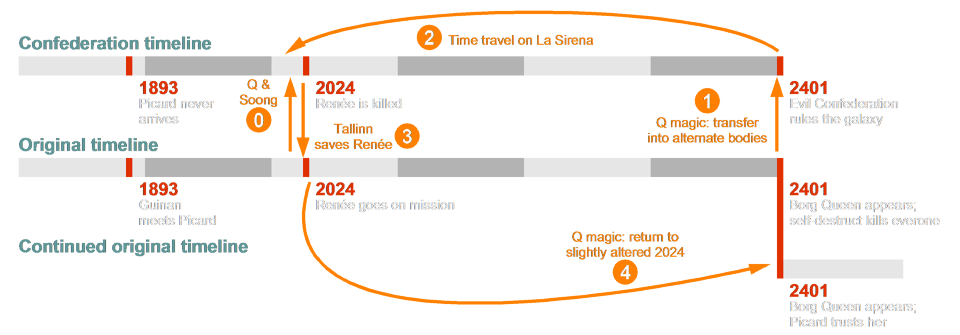
Two concurrent timelines There are two timelines, each of which has its individual past. This gives us five events in which either a change occurs or in which characters travel through time or from one timeline/universe to another. After a normal passage of time, Q appears in 2024, and Soong kills Renée Picard for him (0). In 2401, Q magically transfers Picard and company to their alternate Confederation bodies (1). They then travel back to 2024, prior to the point of divergence, but still on the Confederation timeline (2). Tallinn saves Renée's life and thereby enables a transition to the original timeline (3). Q transfers everyone to 2024 and brings Elnor back (4).
This is a bit more complicated than in the simplistic view. It accounts for the problems of the necessary first incursion (event 0) and of Guinan not knowing Picard, but at the expense of the very difficult explanation how to cross over from the altered year 2024 back to the original timeline. We may include the time travel from TNG: "Time's Arrow" into the considerations, which is only enabled in an intact original timeline, and which itself curiously is a predestined sequence of the event, whereas there are some doubts about the surrounding temporal phenomena in PIC season 2.
On another note about Guinan, there is still the option that she may have been lying to Picard in PIC: "Watcher". She herself is not involved in time travel business but she knows the Watchers. In TOS: "Assignment: Earth", the Watchers aka Supervisors were no time travelers, as Gary Seven explicitly stated. But their nature and mission was redefined and extended in PIC season 2. Wesley is a Traveler and somehow also a Supervisor aka Watcher; he is most definitely a time traveler when he appears in 2024, and he reveals it to Kore. Tallinn also may have some sort of connection to the future. So if Guinan knows the Watchers, her senses would tell her that something is wrong with time. The tricky nature of temporal mechanics may be the reason for her to be cautious when the familiar face of Picard appears in her bar.
Irrespective of which of the basically two timeline diagrams we prefer, they both attribute the temporal effects partly to character actions and partly to Q magic. But what about the many inconsistencies and peculiarities of the story? The vast number of coincidences? Is Q responsible? Or are there other ways to make sense of them?
In PIC: "Penance", it appears much like Q sets Picard up with the "Confederation" scenario. He famously already tampered with time in TNG: "All Good Things", playing by his personal laws of temporal mechanics. At least, there was some logic in it after all, and Captain Picard was eventually able to solve the puzzle. But as hard as we may try, the setting of the "Confederation" is implausible as the result of a time travel incident. The point of divergence is in 2024, and was followed by centuries of Earth's racism and war against aliens. The idea that the very same familiar people, only with extremely different personalities, populate the new timeline is a gross violation of the second law of thermodynamics as well as of genetics. Also, in an actual altered timeline, places and technologies wouldn't be the same after over three centuries of divergent development. In "Penance", Q makes it sound like he wants to punish or test Picard. Considering that it usually would be in his power, he couldn't create a more horrific scenario for Picard than one in which he is an important figure in a fascist empire.
We know that Q tampers with time because he effectively sets off the Confederation timeline when he hires Adam Soong to kill Renée Picard. He is selective about it. He may have chosen a different point of divergence, to create another, perhaps less terrifying future to transfer Picard to. But he deliberately lays the foundation of one in which Picard would become a particularly fearsome and hateful figure. Still, it is extremely hard to believe that, after this one incursion, Q lets the new timeline evolve freely. The second law of thermodynamics makes it hard for Picard, Seven and Jurati to even exist in the new timeline. But the fact that they are all key figures of the Confederation is so preposterous that it has to be a sham. It is safe to say that even if the general scenario is authentic, Q fabricated the characters.
Even if we leave the issue of the design of the Confederation aside (which is a disposable branch of time in spite of everything), Q is definitely guilty of causing the whole trouble in the first place. He creates scenario in which Picard would be faced with a decision in the year 2401 that wouldn't exist without Q's temporal incursion in 2024. Well, Q evidently saves Picard's life when he transfers him, together with Rios, Seven, Raffi, Jurati and Elnor, to the "Confederation" at the end of "The Star Gazer". But that is just part of the plan. We have to wonder anyway why he would he put Picard through such a hardship and bring him into situations the old admiral barely survives. If I understand correctly, all that Q wants is to play one last game, in which Picard is supposed to explore his past and make the right decision for his future. But his ulterior motive, as revealed in "Farewell", is to assure himself of admiral's friendship. Q should have learned enough about humanity to know that you don't torture your friend. And even though we may argue that he was like this all along since "Encounter at Farpoint", his previous two scenarios arranged particularly for Picard to learn something about himself, in "Tapestry" and in "All Good Things", didn't include something like Borg shooting at him. And why is Q so unusually aggressive towards Picard in "Penance"? This all remains unanswered.
Besides the whole Confederation scenario and the roles that the characters play in it, there are many more strange convergences and coincidences. Some were definitely created by Q, such as the multiple occurrences of the number 15 in the château in "Watcher", "Chekhov's gun" that he placed there for Jurati to shoot the Borg Queen in "Fly Me to the Moon" or the key that he left for Picard to find in the solarium in "Hide and Seek". But some of the most blatant coincidences remain unexplained at the end of the season:
- The key person for the good future of humanity is a member of the Picard family.
- The key person for the evil future of humanity is a member of the Soong family.
- Adam Soong not only built the technology for the evil Confederation, he was also involved in the creation of the Augments.
- There are almost eight billion people on Earth, but Picard and Guinan run into someone who has previous experiences with real aliens. Agreed, Wells was actively searching for aliens, but it is a stretch that he would be able to find them, just because of a video that even he himself should rate as a hoax.
- Supervisor Tallinn looks just like Laris. This may still be explained in season 3.
Some more coincidences are of a kind that we are likely to accept in a normal Trek story. For instance, the coordinates that Jurati receives from the Borg Queen are those of Guinan's bar, which may make sense if the Queen somehow had data about aliens on 21st century Earth and possible contacts of Watchers. Likewise, it is plausible why Ricardo, Teresa's son, chose to work on cleaning Earth's atmosphere because he clearly had a strong motivation. It is more difficult to explain why Soji and Dahj look just like Kore but it is not absurd, considering that her image would be somehow engrained in Data, and may have been passed on from one Soong generation to the next. We also may make up an explanation why no one else but Wesley Crusher appears to Kore to hire her for the Travelers aka Supervisors aka Watchers.
It is easier to see how the time travel affects the single characters than to assess the complete picture. Here are some interesting observations:
- Picard: In PIC: "Farewell", Picard puts back the key he found in "Hide and Seek" into the wall of the château. This appears to close a causality loop because young Jean-Luc would find the key some 300 years later, unlock the bedroom door and thereby enable his mother's suicide. If this were true, Q would effectively cause the suicide and Picard's childhood trauma! On the other hand, the act of Picard finding the key and closing the loop may be rather symbolic, as a way to express that the past should not be changed. Realistically, the key would not remain in the wall for 300 years, and even if it did, there is no reason why it should fit into the lock of the 24th century door.
- Raffi: In PIC: "The Star Gazer", Raffi was on the Excelsior when the Borg Queen boarded the Stargazer. In "Farewell", she is on the Stargazer when it happens, unlike Elnor. This doesn't make much sense, and seems to be solely plot-driven, to save the surprise of Elnor being alive for later. Her suddenly being on the Stargazer is not further addressed. But since the crew wonders where Captain Rios has gone, they are probably aware of the discontinuity of her popping up.
- Seven: In PIC: "Hide and Seek", the Borg Queen restores Seven of Nine's implants exactly as they were, although her stomach was injured, not her head or her hands. This is one of the many inconsistencies of the season that are not related to time travel. The question is what would have happened to her in Q's original plan. He possibly would have snapped his fingers and restored the implants, just as he removed them in the first place in "Penance", to make her look right for the Confederation. We have to keep in mind that the latter was not something that actually happened to her in a physical sense but much like pure magic.
- Rios: Rios decides to stay behind in the 21st century. This may appear to be a great risk because of the oft-cited butterflies. However, since several aspects of history already turned out predetermined, this may apply to his being in the 21st century as well. It is possible that he helped or at least inspired Ricardo Ramirez, who worked on the procedure of atmospheric cleaning.
- Elnor: He clearly dies in PIC: "Assimilation", after he was shot in "Penance". Raffi cannot tell whether he would come alive again after the temporal incursion has been reverted. This uncertainty is in part because Elnor, like Raffi, Seven, Picard, Rios and Jurati, was implanted into the reality of the Confederation. This seemingly happened after, but realistically right before the explosion of the ships killed everyone in the original timeline in "The Star Gazer". It would not be far-fetched to assume that Q pulled the same trick again to save Elnor and put him into a kind of limbo when he was deadly wounded. So the Elnor that appears in "Farewell" really is the same person and not just a copy. We don't learn of the memories he has, but he should remember being shot on La Sirena.
- Jurati: Rather than jumping to the future, the new Borg Queen aka Jurati spends some 400 years to build a new Borg Collective. And she probably has to stay out of harm's way that long. An open question in this regard is how she could know about the anomaly that would open in 2401. Did she travel to that future at some point?
One final topic that should be addressed is that the year 2024 as shown in PIC season 3 is certainly not the year 2024 in the real world. There are several differences that go beyond the existence of new people, places and small gadgets. Today's actual technology would neither allow the prolonged Europa Mission to Jupiter's moons nor Soong's shield generator (the prototype of the atmospheric cleaner of the future Confederation). Also, some existing Trek facts are referenced in season 2, such as Jackson Roykirk and his space probe Nomad (TOS: "The Changeling") or the Sanctuary Districts (DS9: "Past Tense"). In TOS, the prospect was that interplanetary travel would be common by the 1990's (TOS: "Space Seed"). But the late 20th and early 21st century technology was retconned in TNG, DS9, VOY and ENT, in a way that space travel sees only moderate progress, effectively aligning Trek history with the real world. Star Trek Picard accounts for the latest developments (or rather lack thereof) by introducing a divergence. Without giving an explanation whether this is the result of a still different time travel, it shows that spaceflight is more advanced in Trek's 2024 than in the real world.
Classification: past incursion with additional tampering and a predestination phenomenon that isn't a complete loop
Addendum
by Paddy Sinclair
One of the issues we face, regardless of the how's and why-for's of the Prime/Confederate Timelines is what is the cause of "predestination" part of Q's scenario, i.e. Jurati becoming the Borg Queen and turning up in 2401 causing the demise of Picard and Q's intervention to "test him".
Whilst speculative, I would posit that this was due to unintended consequences around a temporal incursion at a key point in time on Q's part. This would give as an original (unseen) version of the Prime Timeline which is where Q's interference would started from.
In that version, 2401 is nearly indistinguishable from the one we saw, only the Jurati/Borg don't exist, so don't trigger the circumstances of Q's test, and to the best of our knowledge Jean-Luc Picard does not travel back to 2024 to place Renée Picard back on her path.
Original timeline
- Renée, despite some wobbles is fit for the Europa Mission, and is uniquely placed to discover the microbes and all that comes from that.
- Adam Soong loses his daughter Kore, and in some bitterness looks over the files for Project Khan for something else to remembered to history for - history clearly forgets his role in the coming Eugenics War even if he was actually a major architect.
- Ricardo is likely still involved with implementing the climate solution offered by the microbes.
So from that practically identical timeline, Q does what Q does and turns up to test Picard one more/last time (it might not be his "last" time, as it was when we saw it for reasons that follow...)
Q noticed a delicious little tipping point in history in 2024 that hinged on an ancestor of Jean Luc's and just getting Renée to not embark on the Europa mission was sufficient to the cause, and he snaps back, psyches her out of it and the Confederation Timeline is constructed, with Soong an unwitting beneficiary.
Q's first interference
- Renée wobbles and is unfit for the Europa Mission, and her absence means that the microbes are overlooked somehow. The Europa mission being a bust puts a lid on space exploration for a while given the looming conflicts, no one goes to look on Europa for life anytime soon.
- Adam Soong loses his daughter Kore, and maybe looks over the Project Khan files but does dedicate himself to trying to sort out the looming climate crisis seeing it as an opportunity to create a legacy - he succeeds and ironically the Confederate timeline might have the nicest version of Soong...
Q originally snaps our heroes across to the Confederation timeline somewhat after the point at which we see things happen (for reasons that will become clearer hereafter).
Things transpire pretty much as we see then, but our heroes don't quite behave as Q had expected BUT Q didn't foresee them involving the Borg Queen, and her own machinations and their solution to that. So Picard and crew are stranded in the past without La Sirena and hence no way to get home but remain in past keeping out of the way, so when the corrected timeline ripples down and reasserts itself, Jurati/Borg turns up before he'd originally snapped out heroes across looking for a Picard that doesn't know to trust her and he paradoxes his test of Picard into an alternative timeline. The one we're familiar with.
Timeline as seen in season 2
- Renée having been saved from attempts to disable her, is uniquely placed to discover the microbes and all that comes from that.
- Adam Soong is more than bitter this time, because he knows that he has lost his opportunity to be remembered by history AND he knows Kore resents him for it having erased all his other research files. He is likely the worst version of Soong and still forgotten to history.
- Ricardo is mentored by Rios and possible develops the climate solution earlier.
Q then has to act again to fix his own interference, perhaps at a deep personal cost so that he is now definitely dying if he wasn't before, and possibly why he's now pissy at Jean-Luc. He snaps them across to the handily prepared Confederation Timeline version earlier than he did before (so a clean reset on the original scenario, so we are still in fact going back to the "original timeline").
He knows they'll solve things and he knows the Borg factor and that once they "fix things" he'll have to drop them back in slightly ahead of where he snapped them out so that they can solve his unintended part of the test, and whatever catastrophe creating the Jurati/Borg brought to the 2401 with them.
The differences between this version and the previous one are minimal, as Q manages to patch things up.
And thus now the predestination aspect is set up.
See Also
The Fleet in PIC: "The Star Gazer" and "Farewell" - identification of all ships and information on the designs
Credits
Man screen caps taken from Cygnus-X1.net. Thanks to Stephen Duignan for discussion about the subject. He came up with a logical sequence of events that made me reconsider the possible existence of a timeline that extends to the past.






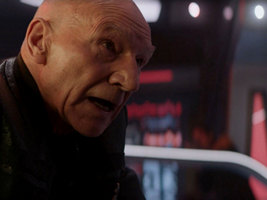
 Picard orders self-destruct in PIC: "The Star Gazer"
Picard orders self-destruct in PIC: "The Star Gazer"